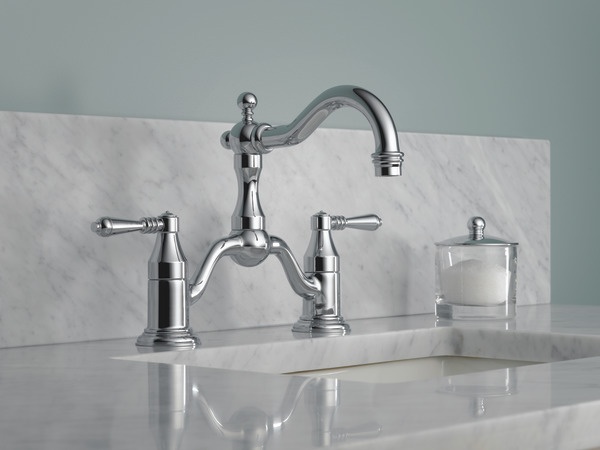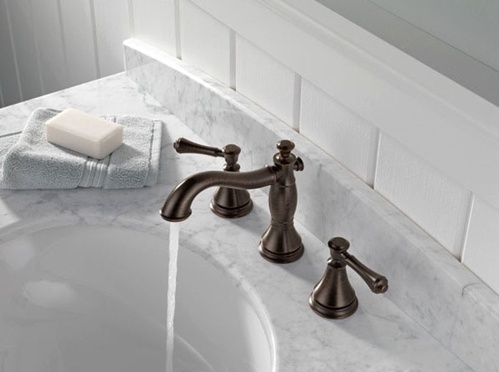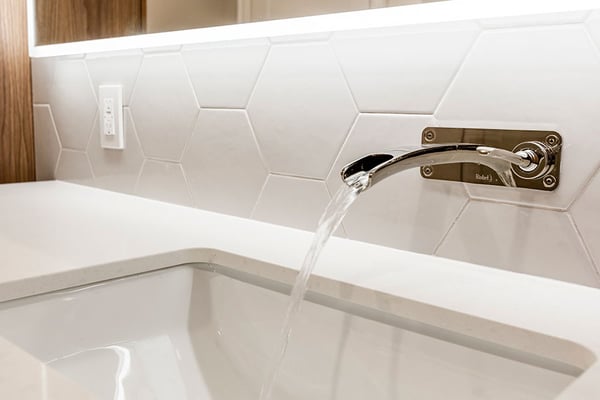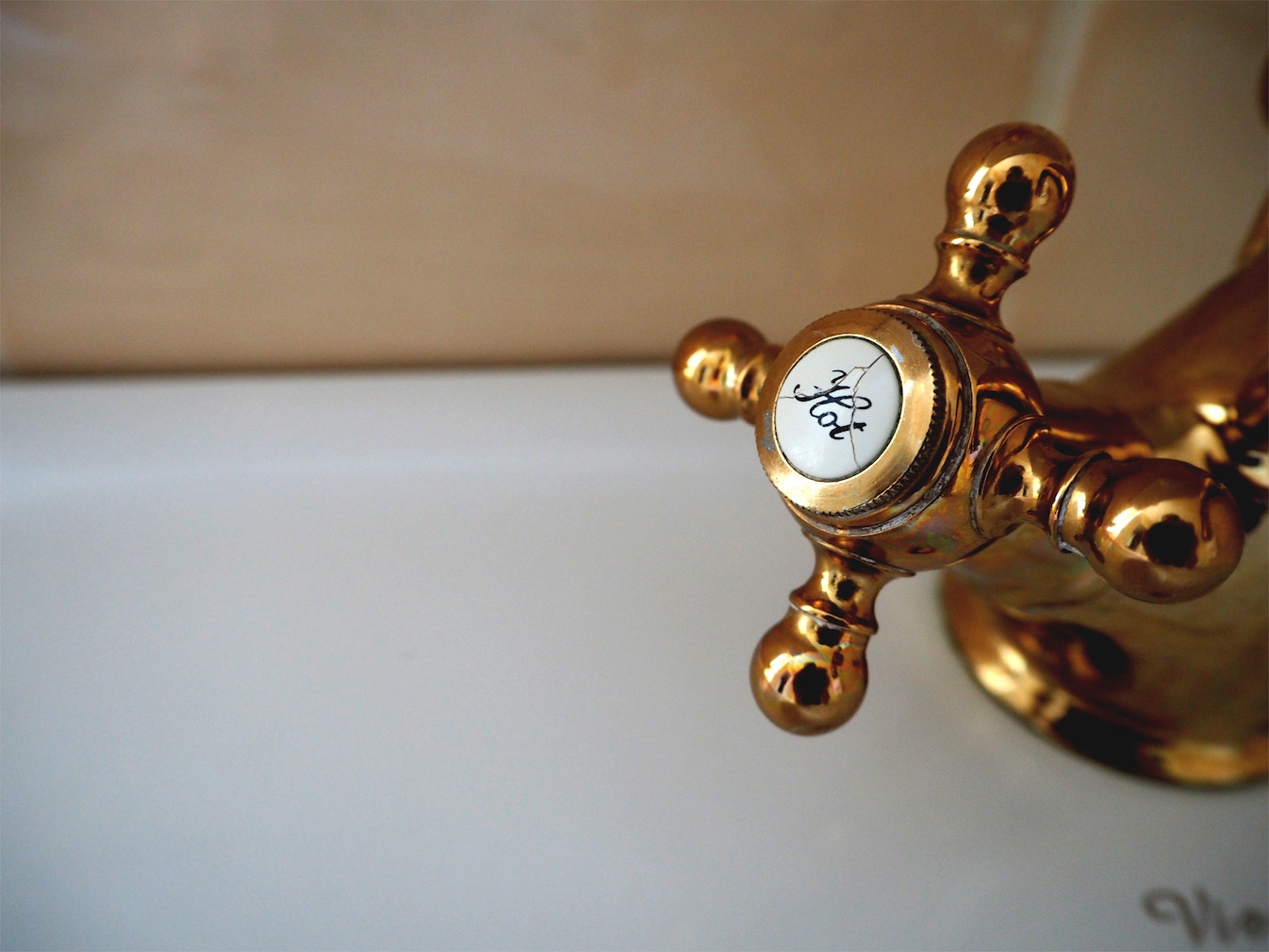Picking out a bathroom sink faucet might be trickier than you would initially imagine. Believe it or not, there are many different types of bathroom faucets available in all kinds of colours, finishes, styles, and sizes. Picking a vanity sink faucet should be done so carefully, as you’ll usually be keeping the same faucet for many years and it should match the overall feel and theme of the room and your other bathroom fixtures.
Keep reading for everything you need to know about the different types of bathroom faucets before you make a purchase.

1. Bridge
If you're looking to combine old-fashioned style with today's technology, bridge faucets might be for you! “Bridge,” according to The Kitchn, means that the levers and the faucet all branch off of one singular part. This requires two holes in the bathroom countertop as opposed to three.
You can often find bridge faucets with undermount sinks. This combination offers you the freedom to experiment with the sink faucet. Usually, bridge faucets are mounted to the bathroom countertop, which also makes it easier to clean around the faucet and therefore easier keep your bathroom sink clean and hygienic.

2. Centre-set
Bathroom faucets that are centre-set work with basins with three holes. Centre-set bathroom faucets have handles that are four inches apart. These faucets include a spout and two handles, one on each side of the base unit. However, some centre-set faucets have two handles that are mounted onto a six-inch plate on the bathroom sink, according to Lowes.

Baril single-handle bathroom faucet
3. Single-handle
Also known as single-lever faucets, single-handle bathroom faucets is exactly what it sounds like—a bathroom faucet with one handle. The singular handle of single-handle faucets controls both the temperature of the water and the water pressure. Single-handle faucets are also a popular style for kitchen faucets as well.
Most single-handle sink faucets only need one or two holes, The Kitchn notes. This means these faucets will only require one hole in the bathroom or kitchen countertop for faucet installation. However, if there are additional holes, some faucets come with a mounting plate to cover the extra holes.
4. Spread-fit
The connection below the vanity sink deck or countertop sink deck is concealed with spread-fit faucets. These faucets have a separate spout and separate handles. Usually, the holes for these sink faucets are placed up to 10 inches away from each other. You can also mount these faucets in nonstandard configurations. For instance, you can position the spout on a rear corner and the handles for the faucet off to one side, which can make it easier for tight installations. This faucet is very similar to the centre-set bathroom faucet.
5. Deck mount
A “deck mount” faucet, according to The Kitchn, is a sink faucet that mounts directly to the bathroom or kitchen countertop. This type of faucet varies from other bathroom faucets that mount to the wall or to the sink itself. Deck mount faucets can also be used for bathtubs as well as bathroom sink faucets.

Riobel wall-mounted faucet, photo from Lucas Richard
6. Wall-mount
Wall-mounted faucets are attached to the wall, as opposed to being attached to the sink or to the counter like a deck-mounted faucet or tap. These faucets extend over the sink and are available in a wide variety of styles, sizes, colours, and finishes.
“Many people choose a wall-mounted fixture because of its clean appearance; it’s a style that’s both modern and utilitarian-looking,” designer Malachi Connolly told Remodelista.
The main advantage of a wall mount faucet on a vanity sink is that it makes it easier to keep the area around your sink clean. Since dirt and calcium deposits tend to build up at the back of a sink, it’s a crucial area to clean. It's definitely easier to reach without a faucet and hardware in the way.

7. Vessel
According to The Spruce, “a vessel sink is a basin that sits on top of a bathroom vanity or counters rather than inset like traditional drop-in or undermount sinks.” A vessel sink basin can be made of any material. Fired ceramic, glass, stainless steel, stone, copper, and marble are all options for vessel sinks. However, glass and ceramic are the most popular materials used for vessel sinks today. You will generally find a vessel sink in a bathroom, not a kitchen.
For the faucet configuration on a vessel sink, holes are drilled into the countertop or bathroom vanity for the sink faucet. You can choose if you want a single-hole or double-hole configuration for your vessel sink faucet. For a vessel sink, you can also choose to have either a wall mount or a deck mount faucet.
There are faucets available that are specifically made for vessel sinks. These faucets clear the high rim of the vessel sink basin. Usually, a faucet needs to be four inches to clear most vessel sink basins.
Before picking out a bathroom sink faucet, review the options to get a sense of what you're looking for. Then, stop by a Kitchen & Bath Classics showroom where you’ll find all kinds of bathroom faucets including Riobel faucets and many more brands we carry.



